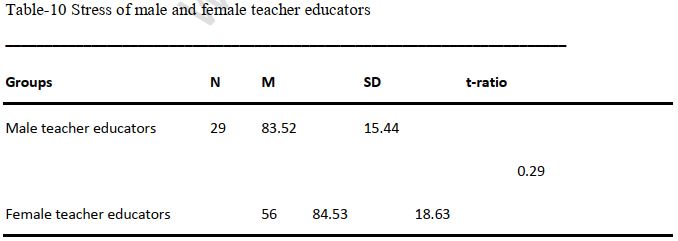STRESS AMONG TEACHER EDUCATORS FROM SELF-FINANCING COLLEGES OF EDUCATION
Abstract
This study examined the factors which contribute stress among the teacher educators who are currently teaching in self-financing colleges of education affiliated to Kurukshetra University, Haryana. There were five sources of teacher stress that included in this study: time management, work related stressors, professional distress, discipline and motivation and professional investment. A total of 85 teacher educators (N=85) from 12 self-financing colleges of education affiliated to Kurukshetra University of Haryana state were selected randomly to represent the population. The sample of the present investigation constituted of 29 male and 56 female teacher educators. The instrument used to measure the teacher stress was the adapted version (adapted by Rubina Hanif, 2004) of Teacher Stress Inventory constructed by Fimian (1985). The alpha Croncbach for the instrument in the present study was .85. The data were analyzed using both descriptive (mean, frequency and percentage) and inferential (t-test) statistics. The results indicate no significant difference of teacher stress among the respondents based on gender. But significant differences were found between the stress of teacher educators who teach fifty and more students in the class, between the stress of teacher educators who teach less than four periods a day and teacher educators who teach more than four periods a day, between the stress of teacher educators having three and more years of teaching experience and teacher educators having less than three years of teaching experience.
Downloads
References
Antoniou A. S., Polychroni, F., Vlachakis, A. N. (2006). Gender and age differences in occupational stress and professional burnout between primary and high-school teachers in Greece. J Manage Psycho, 21, 682-90.
Arnold, J. (1999). Affect in language learning. Cambridge: Cambridge University Press.
Fimian, M. J. (1983). A comparison of occupational stress correlates as reported by teachers of mentally retarded and non-mentally retarded handicapped children. Education and Training of the Mentally Retarded, 18, 62-68.
Hadi, A. A., Naing, N. N., Daud, A., Nordin, R., & Sulong, M. R. (2009). Prevalence and factors associated with stress among secondary school teachers in Kota Bharu, Kelantan, Malaysia. Southeast Asian Trop Med Public Health, 40, (6), 1359-1370.
Hanif, R. (2004). Teacher stress, job performance and self-efficacy of women school teachers. Doctoral Dissertation, National Institute of Psychology, Centre of Excellence Quaid-i-Azam University, Islamabad.
Hanizah, M. Y. (2003). The effect of information technology usage on the prevalence of stress among school teachers in Selangor and factors affecting the stress. Master Thesis, University Kebangsaan, Kuala Lumpur, Malaysia, 110.
Kyriacou, C. (2001). Teacher stress: Directions for future research. Educational Review 53, (1), 27–35.















